Business Finance Report: Trend Ltd. Cash Flow and Working Capital
VerifiedAdded on 2022/12/26
|12
|3096
|42
Report
AI Summary
This report provides a detailed analysis of the business finance practices of Trend Ltd., a company manufacturing gym clothing and footwear. The report explores key concepts such as profit, cash flow, working capital, receivables, inventories, and payables, and assesses their impact on the company's financial results. It explains the difference between profit and cash flow, and how working capital management influences cash flow. The report highlights the impact of the company's operational management on its financial results, particularly focusing on the actions of the owner, Arpha, and the management of working capital. It concludes with recommendations to improve the company's cash flow through better working capital management, including strategies for debt recovery, dispute resolution, and inventory control. Additionally, the report includes an executive summary and a section on the business finance practices of Thorne Estates Limited, with a focus on cash budgeting and recommendations for improved cash management, especially considering the challenges faced by the company.
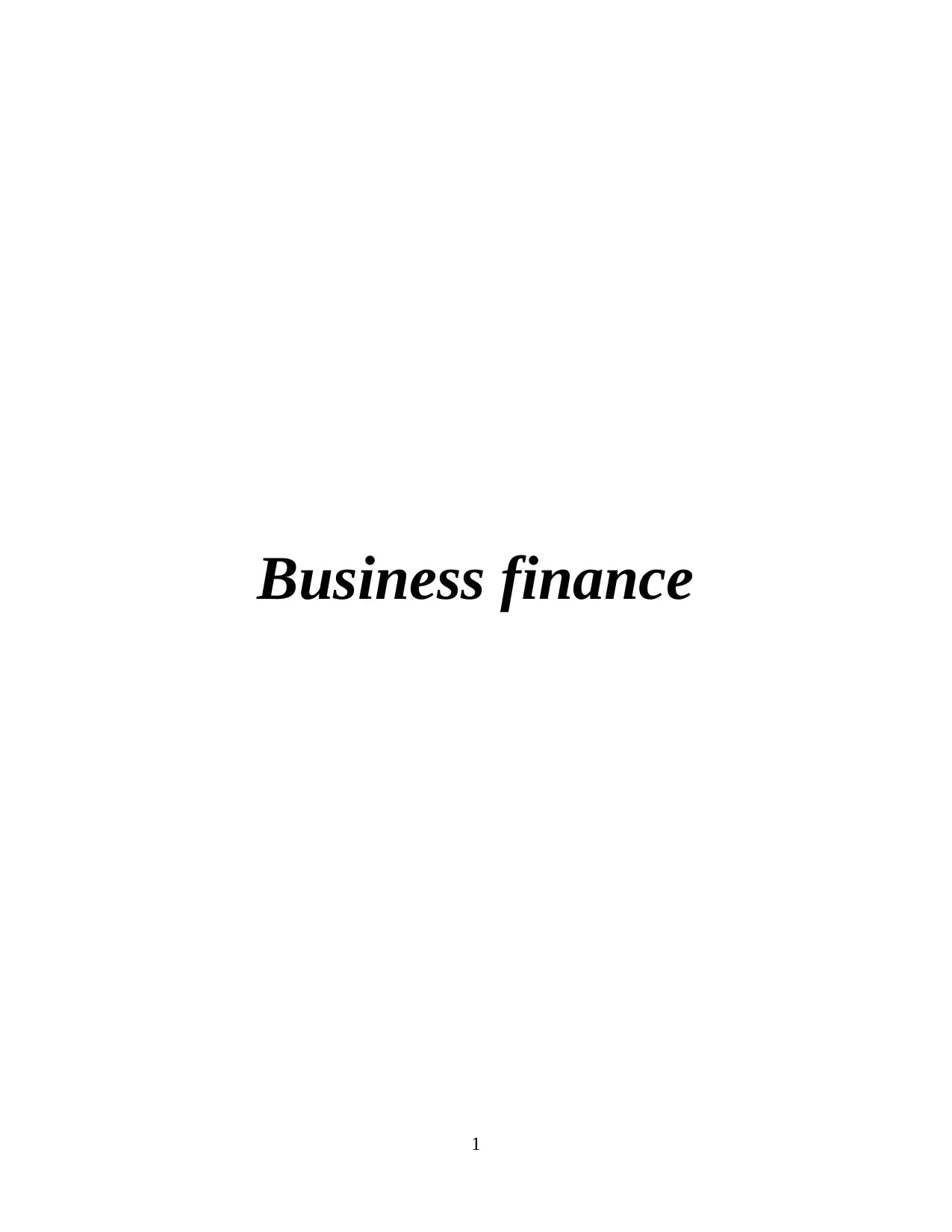
Business finance
1
1
Paraphrase This Document
Need a fresh take? Get an instant paraphrase of this document with our AI Paraphraser
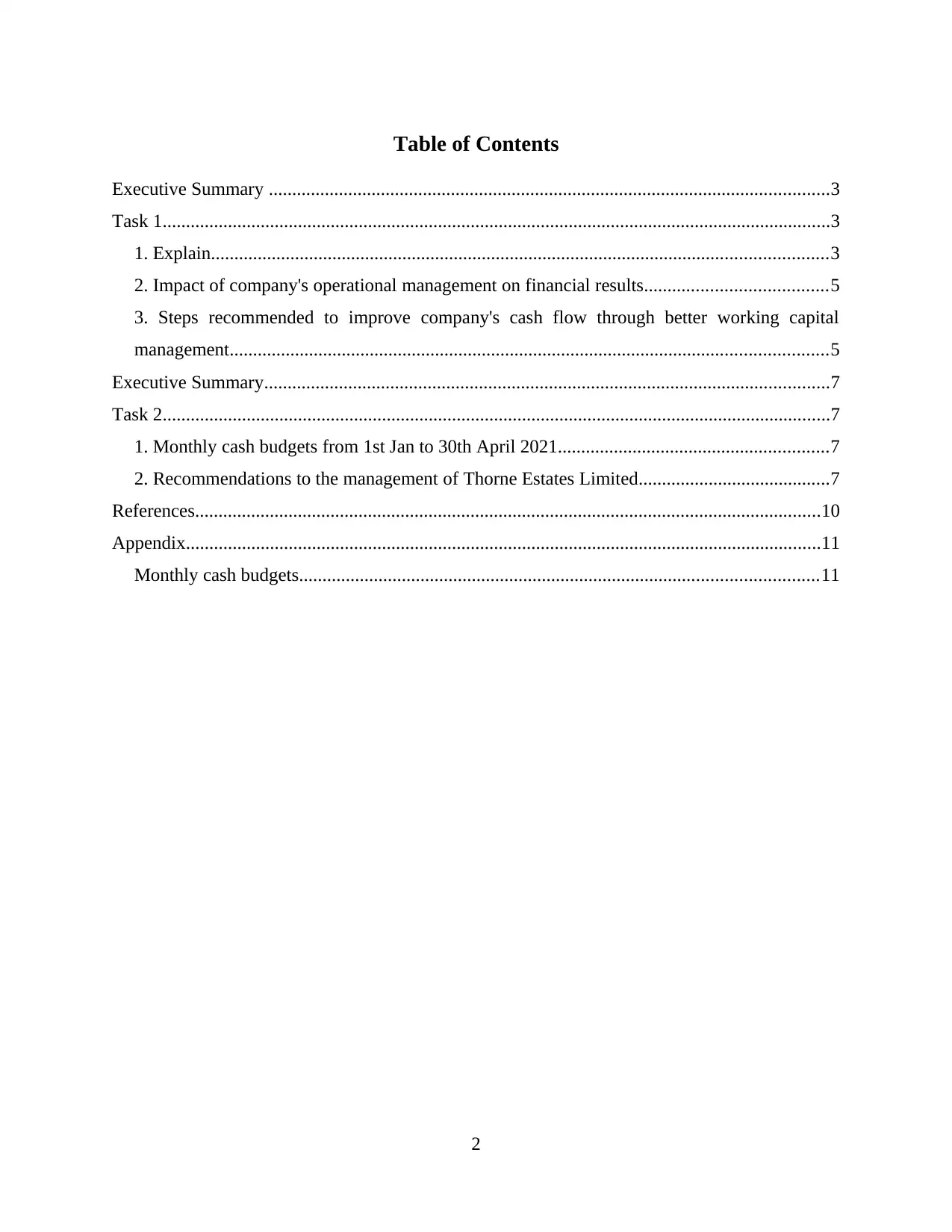
Table of Contents
Executive Summary ........................................................................................................................3
Task 1...............................................................................................................................................3
1. Explain....................................................................................................................................3
2. Impact of company's operational management on financial results.......................................5
3. Steps recommended to improve company's cash flow through better working capital
management................................................................................................................................5
Executive Summary.........................................................................................................................7
Task 2...............................................................................................................................................7
1. Monthly cash budgets from 1st Jan to 30th April 2021..........................................................7
2. Recommendations to the management of Thorne Estates Limited.........................................7
References......................................................................................................................................10
Appendix........................................................................................................................................11
Monthly cash budgets...............................................................................................................11
2
Executive Summary ........................................................................................................................3
Task 1...............................................................................................................................................3
1. Explain....................................................................................................................................3
2. Impact of company's operational management on financial results.......................................5
3. Steps recommended to improve company's cash flow through better working capital
management................................................................................................................................5
Executive Summary.........................................................................................................................7
Task 2...............................................................................................................................................7
1. Monthly cash budgets from 1st Jan to 30th April 2021..........................................................7
2. Recommendations to the management of Thorne Estates Limited.........................................7
References......................................................................................................................................10
Appendix........................................................................................................................................11
Monthly cash budgets...............................................................................................................11
2
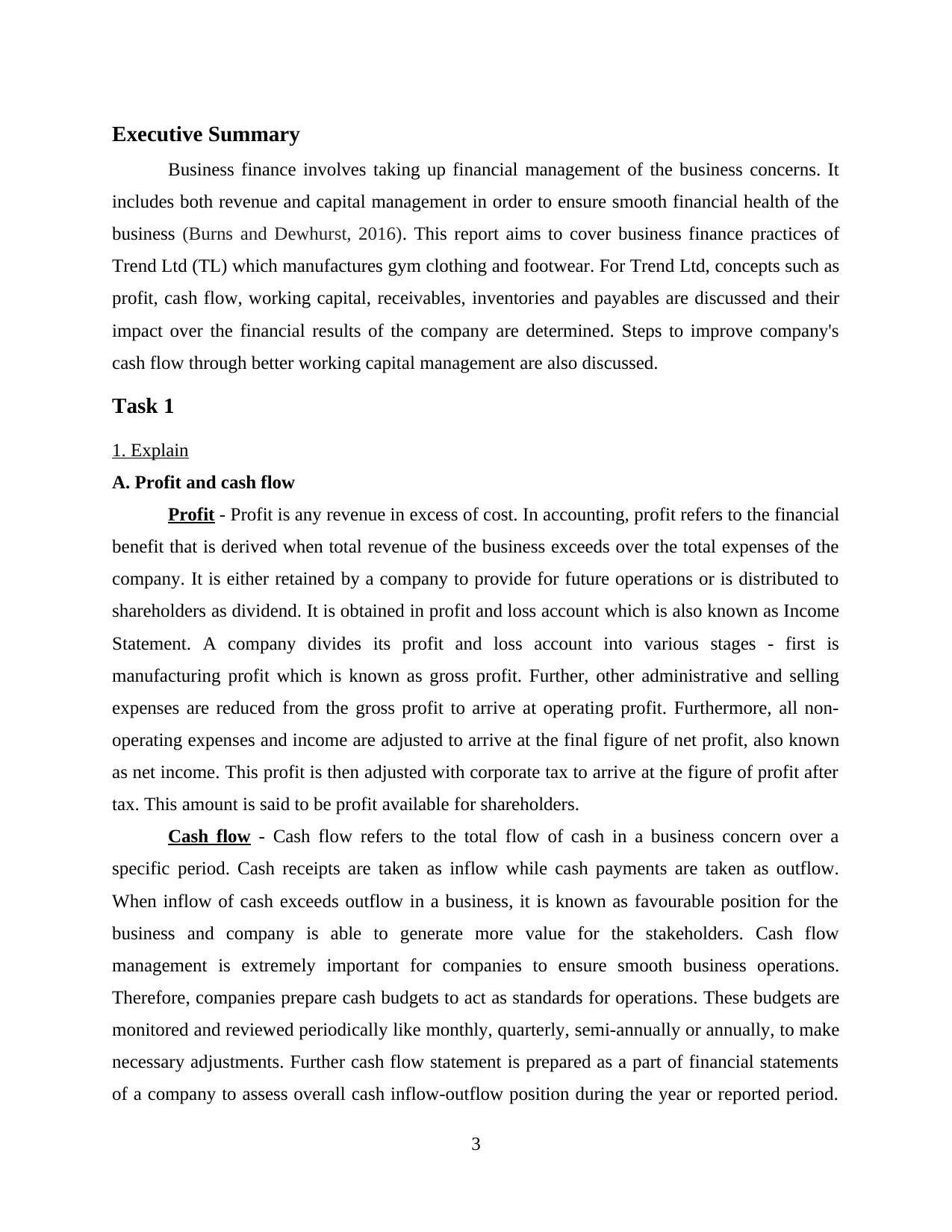
Executive Summary
Business finance involves taking up financial management of the business concerns. It
includes both revenue and capital management in order to ensure smooth financial health of the
business (Burns and Dewhurst, 2016). This report aims to cover business finance practices of
Trend Ltd (TL) which manufactures gym clothing and footwear. For Trend Ltd, concepts such as
profit, cash flow, working capital, receivables, inventories and payables are discussed and their
impact over the financial results of the company are determined. Steps to improve company's
cash flow through better working capital management are also discussed.
Task 1
1. Explain
A. Profit and cash flow
Profit - Profit is any revenue in excess of cost. In accounting, profit refers to the financial
benefit that is derived when total revenue of the business exceeds over the total expenses of the
company. It is either retained by a company to provide for future operations or is distributed to
shareholders as dividend. It is obtained in profit and loss account which is also known as Income
Statement. A company divides its profit and loss account into various stages - first is
manufacturing profit which is known as gross profit. Further, other administrative and selling
expenses are reduced from the gross profit to arrive at operating profit. Furthermore, all non-
operating expenses and income are adjusted to arrive at the final figure of net profit, also known
as net income. This profit is then adjusted with corporate tax to arrive at the figure of profit after
tax. This amount is said to be profit available for shareholders.
Cash flow - Cash flow refers to the total flow of cash in a business concern over a
specific period. Cash receipts are taken as inflow while cash payments are taken as outflow.
When inflow of cash exceeds outflow in a business, it is known as favourable position for the
business and company is able to generate more value for the stakeholders. Cash flow
management is extremely important for companies to ensure smooth business operations.
Therefore, companies prepare cash budgets to act as standards for operations. These budgets are
monitored and reviewed periodically like monthly, quarterly, semi-annually or annually, to make
necessary adjustments. Further cash flow statement is prepared as a part of financial statements
of a company to assess overall cash inflow-outflow position during the year or reported period.
3
Business finance involves taking up financial management of the business concerns. It
includes both revenue and capital management in order to ensure smooth financial health of the
business (Burns and Dewhurst, 2016). This report aims to cover business finance practices of
Trend Ltd (TL) which manufactures gym clothing and footwear. For Trend Ltd, concepts such as
profit, cash flow, working capital, receivables, inventories and payables are discussed and their
impact over the financial results of the company are determined. Steps to improve company's
cash flow through better working capital management are also discussed.
Task 1
1. Explain
A. Profit and cash flow
Profit - Profit is any revenue in excess of cost. In accounting, profit refers to the financial
benefit that is derived when total revenue of the business exceeds over the total expenses of the
company. It is either retained by a company to provide for future operations or is distributed to
shareholders as dividend. It is obtained in profit and loss account which is also known as Income
Statement. A company divides its profit and loss account into various stages - first is
manufacturing profit which is known as gross profit. Further, other administrative and selling
expenses are reduced from the gross profit to arrive at operating profit. Furthermore, all non-
operating expenses and income are adjusted to arrive at the final figure of net profit, also known
as net income. This profit is then adjusted with corporate tax to arrive at the figure of profit after
tax. This amount is said to be profit available for shareholders.
Cash flow - Cash flow refers to the total flow of cash in a business concern over a
specific period. Cash receipts are taken as inflow while cash payments are taken as outflow.
When inflow of cash exceeds outflow in a business, it is known as favourable position for the
business and company is able to generate more value for the stakeholders. Cash flow
management is extremely important for companies to ensure smooth business operations.
Therefore, companies prepare cash budgets to act as standards for operations. These budgets are
monitored and reviewed periodically like monthly, quarterly, semi-annually or annually, to make
necessary adjustments. Further cash flow statement is prepared as a part of financial statements
of a company to assess overall cash inflow-outflow position during the year or reported period.
3
⊘ This is a preview!⊘
Do you want full access?
Subscribe today to unlock all pages.

Trusted by 1+ million students worldwide
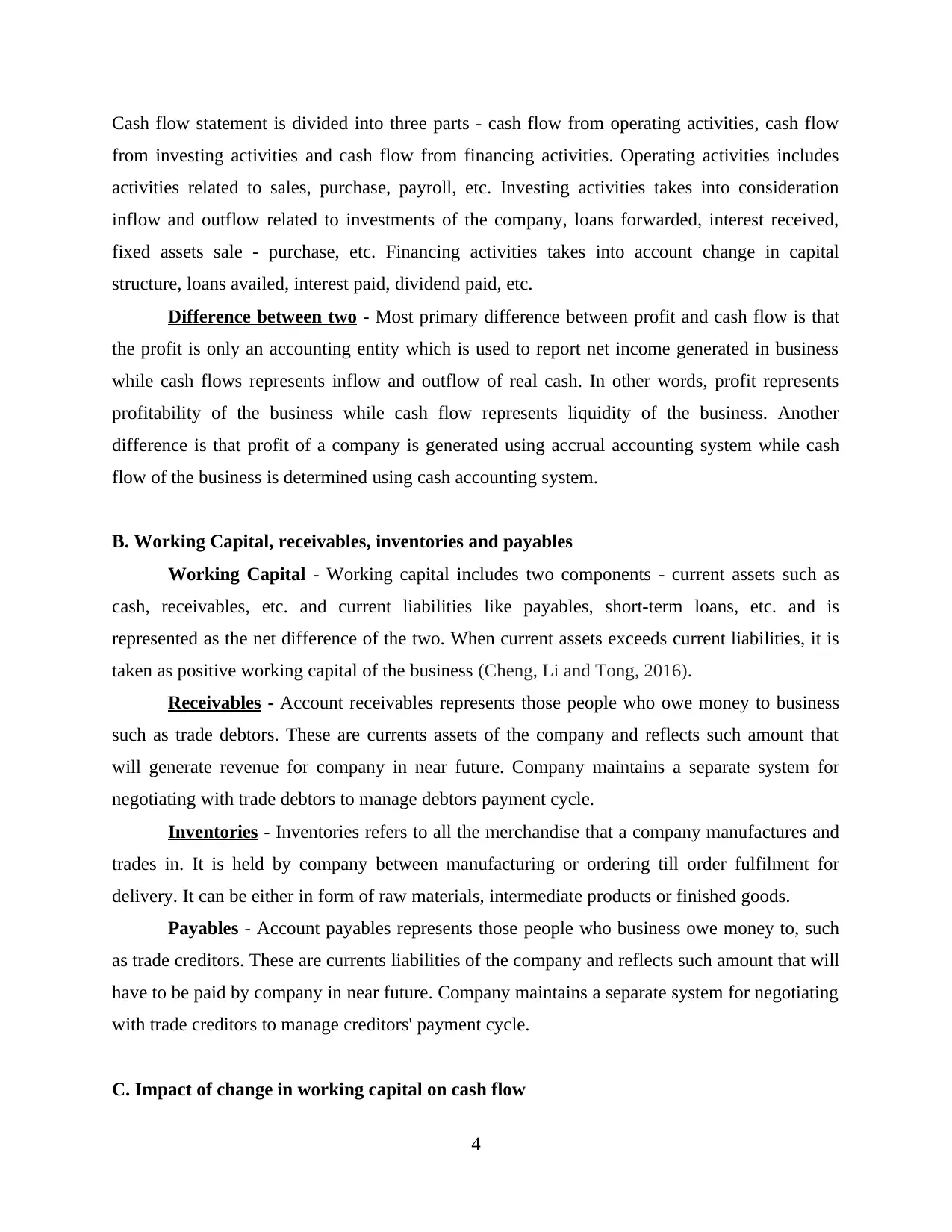
Cash flow statement is divided into three parts - cash flow from operating activities, cash flow
from investing activities and cash flow from financing activities. Operating activities includes
activities related to sales, purchase, payroll, etc. Investing activities takes into consideration
inflow and outflow related to investments of the company, loans forwarded, interest received,
fixed assets sale - purchase, etc. Financing activities takes into account change in capital
structure, loans availed, interest paid, dividend paid, etc.
Difference between two - Most primary difference between profit and cash flow is that
the profit is only an accounting entity which is used to report net income generated in business
while cash flows represents inflow and outflow of real cash. In other words, profit represents
profitability of the business while cash flow represents liquidity of the business. Another
difference is that profit of a company is generated using accrual accounting system while cash
flow of the business is determined using cash accounting system.
B. Working Capital, receivables, inventories and payables
Working Capital - Working capital includes two components - current assets such as
cash, receivables, etc. and current liabilities like payables, short-term loans, etc. and is
represented as the net difference of the two. When current assets exceeds current liabilities, it is
taken as positive working capital of the business (Cheng, Li and Tong, 2016).
Receivables - Account receivables represents those people who owe money to business
such as trade debtors. These are currents assets of the company and reflects such amount that
will generate revenue for company in near future. Company maintains a separate system for
negotiating with trade debtors to manage debtors payment cycle.
Inventories - Inventories refers to all the merchandise that a company manufactures and
trades in. It is held by company between manufacturing or ordering till order fulfilment for
delivery. It can be either in form of raw materials, intermediate products or finished goods.
Payables - Account payables represents those people who business owe money to, such
as trade creditors. These are currents liabilities of the company and reflects such amount that will
have to be paid by company in near future. Company maintains a separate system for negotiating
with trade creditors to manage creditors' payment cycle.
C. Impact of change in working capital on cash flow
4
from investing activities and cash flow from financing activities. Operating activities includes
activities related to sales, purchase, payroll, etc. Investing activities takes into consideration
inflow and outflow related to investments of the company, loans forwarded, interest received,
fixed assets sale - purchase, etc. Financing activities takes into account change in capital
structure, loans availed, interest paid, dividend paid, etc.
Difference between two - Most primary difference between profit and cash flow is that
the profit is only an accounting entity which is used to report net income generated in business
while cash flows represents inflow and outflow of real cash. In other words, profit represents
profitability of the business while cash flow represents liquidity of the business. Another
difference is that profit of a company is generated using accrual accounting system while cash
flow of the business is determined using cash accounting system.
B. Working Capital, receivables, inventories and payables
Working Capital - Working capital includes two components - current assets such as
cash, receivables, etc. and current liabilities like payables, short-term loans, etc. and is
represented as the net difference of the two. When current assets exceeds current liabilities, it is
taken as positive working capital of the business (Cheng, Li and Tong, 2016).
Receivables - Account receivables represents those people who owe money to business
such as trade debtors. These are currents assets of the company and reflects such amount that
will generate revenue for company in near future. Company maintains a separate system for
negotiating with trade debtors to manage debtors payment cycle.
Inventories - Inventories refers to all the merchandise that a company manufactures and
trades in. It is held by company between manufacturing or ordering till order fulfilment for
delivery. It can be either in form of raw materials, intermediate products or finished goods.
Payables - Account payables represents those people who business owe money to, such
as trade creditors. These are currents liabilities of the company and reflects such amount that will
have to be paid by company in near future. Company maintains a separate system for negotiating
with trade creditors to manage creditors' payment cycle.
C. Impact of change in working capital on cash flow
4
Paraphrase This Document
Need a fresh take? Get an instant paraphrase of this document with our AI Paraphraser
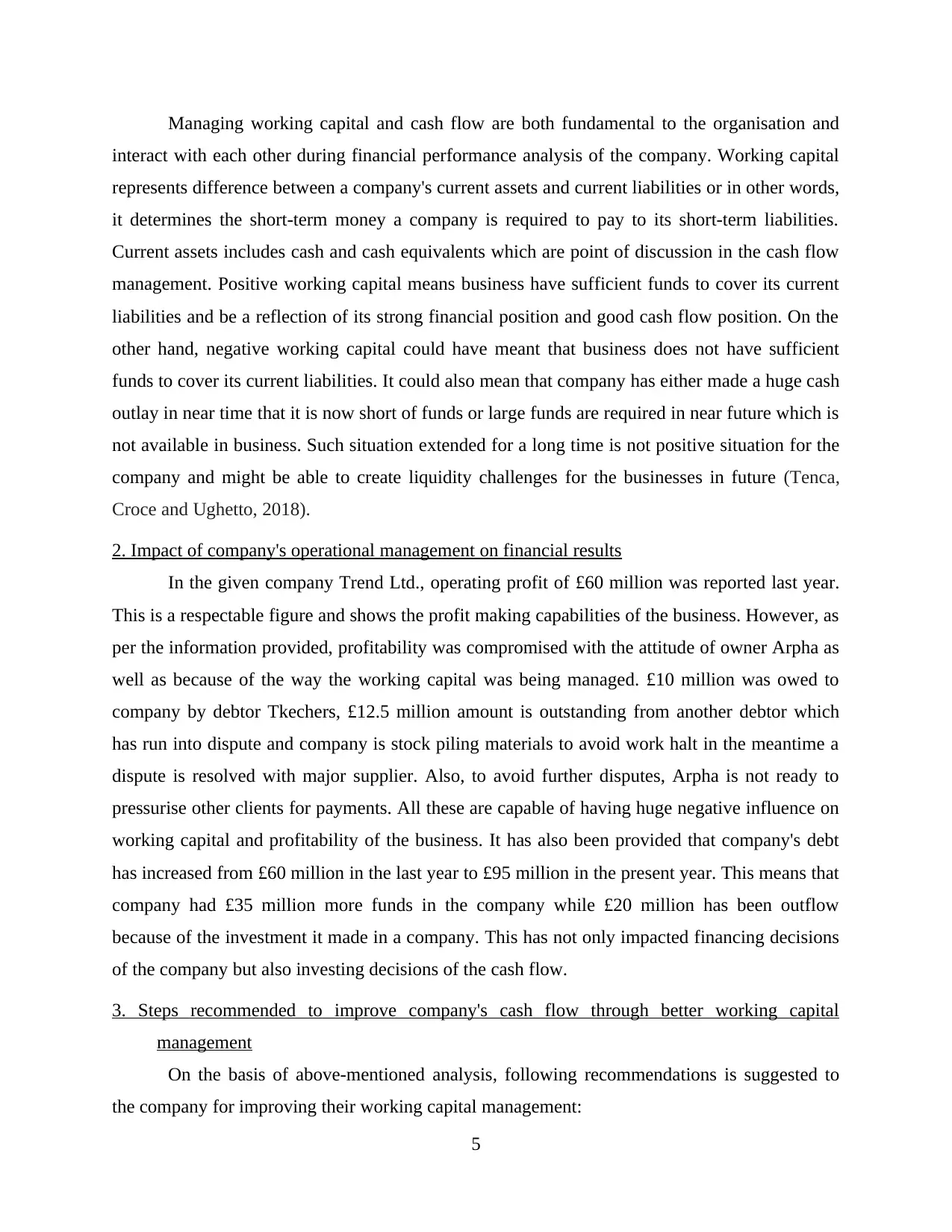
Managing working capital and cash flow are both fundamental to the organisation and
interact with each other during financial performance analysis of the company. Working capital
represents difference between a company's current assets and current liabilities or in other words,
it determines the short-term money a company is required to pay to its short-term liabilities.
Current assets includes cash and cash equivalents which are point of discussion in the cash flow
management. Positive working capital means business have sufficient funds to cover its current
liabilities and be a reflection of its strong financial position and good cash flow position. On the
other hand, negative working capital could have meant that business does not have sufficient
funds to cover its current liabilities. It could also mean that company has either made a huge cash
outlay in near time that it is now short of funds or large funds are required in near future which is
not available in business. Such situation extended for a long time is not positive situation for the
company and might be able to create liquidity challenges for the businesses in future (Tenca,
Croce and Ughetto, 2018).
2. Impact of company's operational management on financial results
In the given company Trend Ltd., operating profit of £60 million was reported last year.
This is a respectable figure and shows the profit making capabilities of the business. However, as
per the information provided, profitability was compromised with the attitude of owner Arpha as
well as because of the way the working capital was being managed. £10 million was owed to
company by debtor Tkechers, £12.5 million amount is outstanding from another debtor which
has run into dispute and company is stock piling materials to avoid work halt in the meantime a
dispute is resolved with major supplier. Also, to avoid further disputes, Arpha is not ready to
pressurise other clients for payments. All these are capable of having huge negative influence on
working capital and profitability of the business. It has also been provided that company's debt
has increased from £60 million in the last year to £95 million in the present year. This means that
company had £35 million more funds in the company while £20 million has been outflow
because of the investment it made in a company. This has not only impacted financing decisions
of the company but also investing decisions of the cash flow.
3. Steps recommended to improve company's cash flow through better working capital
management
On the basis of above-mentioned analysis, following recommendations is suggested to
the company for improving their working capital management:
5
interact with each other during financial performance analysis of the company. Working capital
represents difference between a company's current assets and current liabilities or in other words,
it determines the short-term money a company is required to pay to its short-term liabilities.
Current assets includes cash and cash equivalents which are point of discussion in the cash flow
management. Positive working capital means business have sufficient funds to cover its current
liabilities and be a reflection of its strong financial position and good cash flow position. On the
other hand, negative working capital could have meant that business does not have sufficient
funds to cover its current liabilities. It could also mean that company has either made a huge cash
outlay in near time that it is now short of funds or large funds are required in near future which is
not available in business. Such situation extended for a long time is not positive situation for the
company and might be able to create liquidity challenges for the businesses in future (Tenca,
Croce and Ughetto, 2018).
2. Impact of company's operational management on financial results
In the given company Trend Ltd., operating profit of £60 million was reported last year.
This is a respectable figure and shows the profit making capabilities of the business. However, as
per the information provided, profitability was compromised with the attitude of owner Arpha as
well as because of the way the working capital was being managed. £10 million was owed to
company by debtor Tkechers, £12.5 million amount is outstanding from another debtor which
has run into dispute and company is stock piling materials to avoid work halt in the meantime a
dispute is resolved with major supplier. Also, to avoid further disputes, Arpha is not ready to
pressurise other clients for payments. All these are capable of having huge negative influence on
working capital and profitability of the business. It has also been provided that company's debt
has increased from £60 million in the last year to £95 million in the present year. This means that
company had £35 million more funds in the company while £20 million has been outflow
because of the investment it made in a company. This has not only impacted financing decisions
of the company but also investing decisions of the cash flow.
3. Steps recommended to improve company's cash flow through better working capital
management
On the basis of above-mentioned analysis, following recommendations is suggested to
the company for improving their working capital management:
5
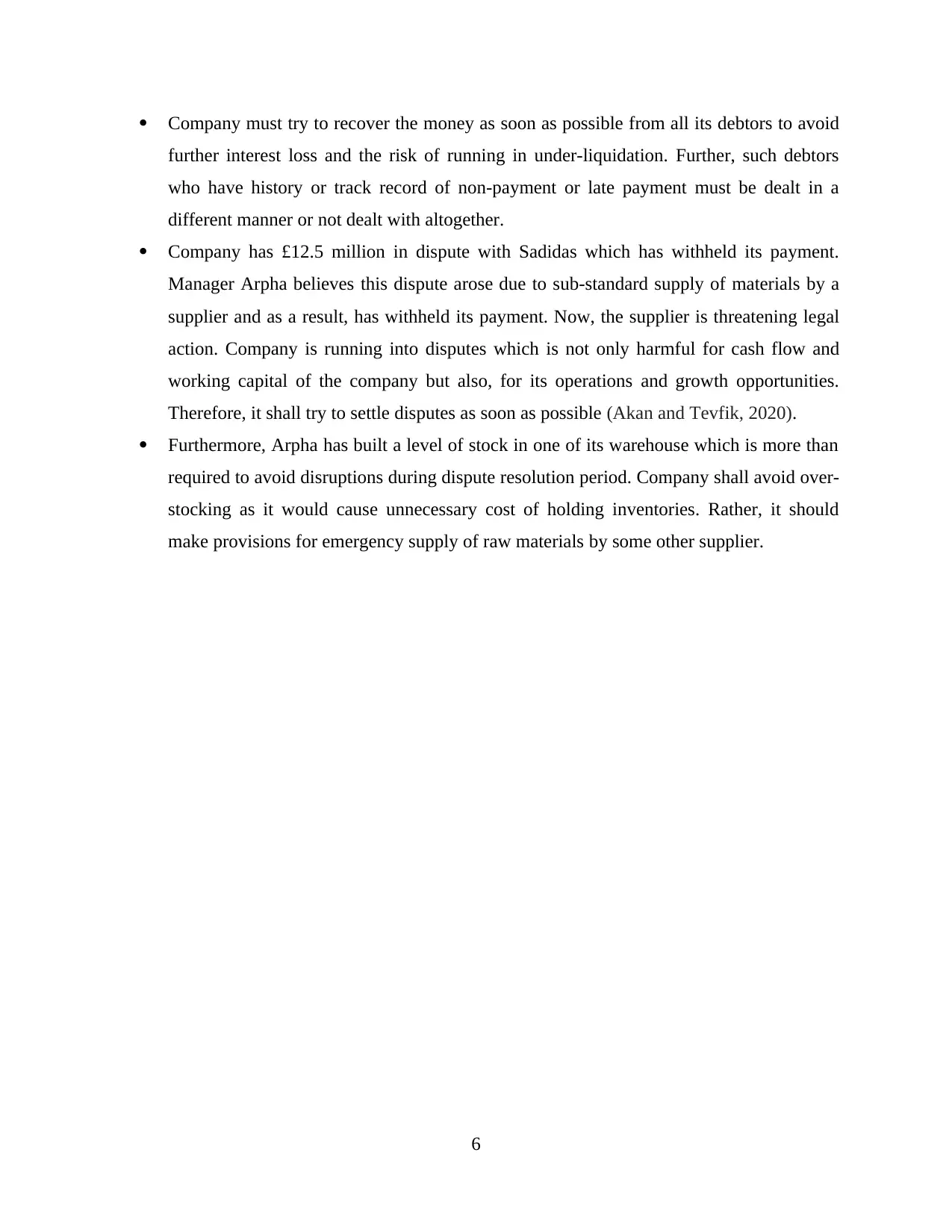
Company must try to recover the money as soon as possible from all its debtors to avoid
further interest loss and the risk of running in under-liquidation. Further, such debtors
who have history or track record of non-payment or late payment must be dealt in a
different manner or not dealt with altogether.
Company has £12.5 million in dispute with Sadidas which has withheld its payment.
Manager Arpha believes this dispute arose due to sub-standard supply of materials by a
supplier and as a result, has withheld its payment. Now, the supplier is threatening legal
action. Company is running into disputes which is not only harmful for cash flow and
working capital of the company but also, for its operations and growth opportunities.
Therefore, it shall try to settle disputes as soon as possible (Akan and Tevfik, 2020).
Furthermore, Arpha has built a level of stock in one of its warehouse which is more than
required to avoid disruptions during dispute resolution period. Company shall avoid over-
stocking as it would cause unnecessary cost of holding inventories. Rather, it should
make provisions for emergency supply of raw materials by some other supplier.
6
further interest loss and the risk of running in under-liquidation. Further, such debtors
who have history or track record of non-payment or late payment must be dealt in a
different manner or not dealt with altogether.
Company has £12.5 million in dispute with Sadidas which has withheld its payment.
Manager Arpha believes this dispute arose due to sub-standard supply of materials by a
supplier and as a result, has withheld its payment. Now, the supplier is threatening legal
action. Company is running into disputes which is not only harmful for cash flow and
working capital of the company but also, for its operations and growth opportunities.
Therefore, it shall try to settle disputes as soon as possible (Akan and Tevfik, 2020).
Furthermore, Arpha has built a level of stock in one of its warehouse which is more than
required to avoid disruptions during dispute resolution period. Company shall avoid over-
stocking as it would cause unnecessary cost of holding inventories. Rather, it should
make provisions for emergency supply of raw materials by some other supplier.
6
⊘ This is a preview!⊘
Do you want full access?
Subscribe today to unlock all pages.

Trusted by 1+ million students worldwide
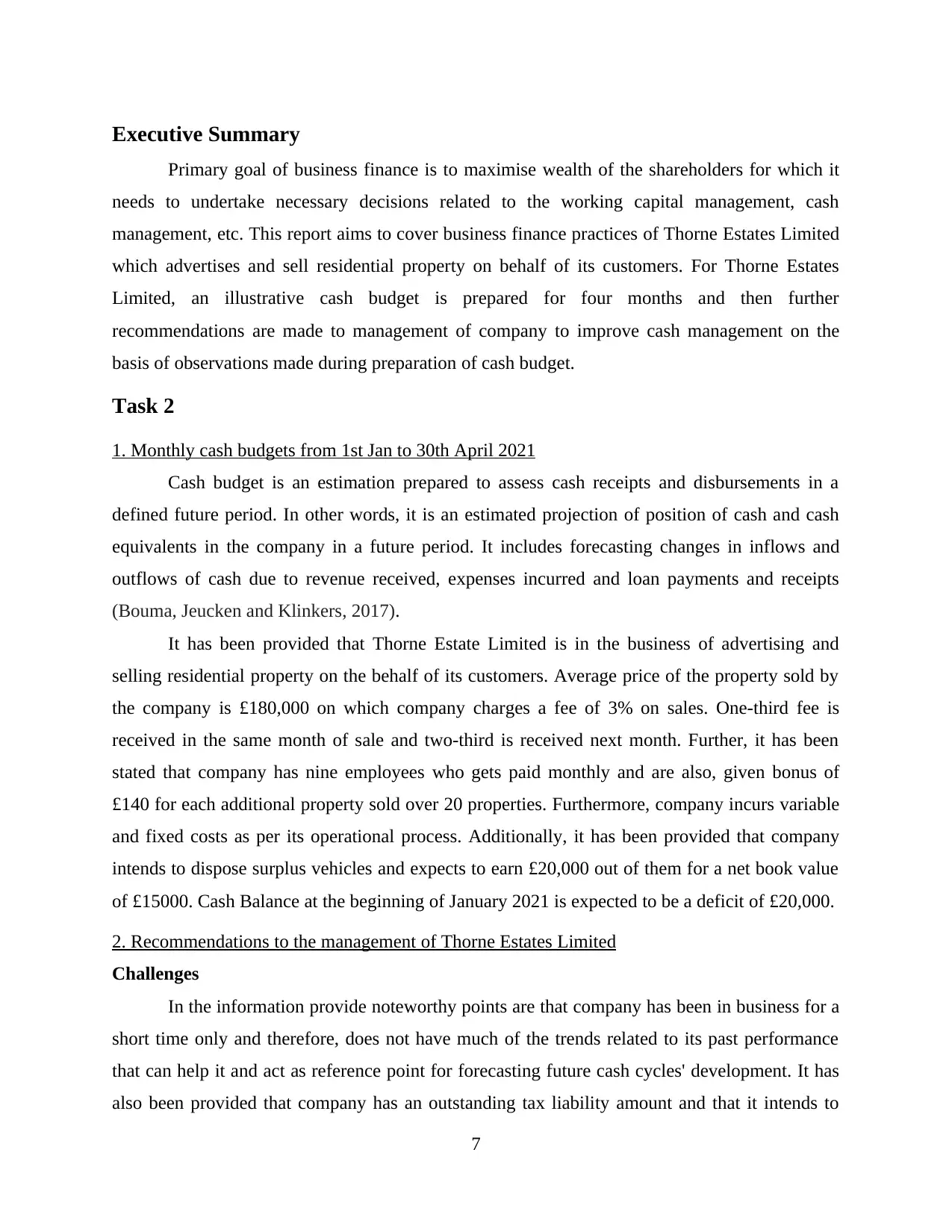
Executive Summary
Primary goal of business finance is to maximise wealth of the shareholders for which it
needs to undertake necessary decisions related to the working capital management, cash
management, etc. This report aims to cover business finance practices of Thorne Estates Limited
which advertises and sell residential property on behalf of its customers. For Thorne Estates
Limited, an illustrative cash budget is prepared for four months and then further
recommendations are made to management of company to improve cash management on the
basis of observations made during preparation of cash budget.
Task 2
1. Monthly cash budgets from 1st Jan to 30th April 2021
Cash budget is an estimation prepared to assess cash receipts and disbursements in a
defined future period. In other words, it is an estimated projection of position of cash and cash
equivalents in the company in a future period. It includes forecasting changes in inflows and
outflows of cash due to revenue received, expenses incurred and loan payments and receipts
(Bouma, Jeucken and Klinkers, 2017).
It has been provided that Thorne Estate Limited is in the business of advertising and
selling residential property on the behalf of its customers. Average price of the property sold by
the company is £180,000 on which company charges a fee of 3% on sales. One-third fee is
received in the same month of sale and two-third is received next month. Further, it has been
stated that company has nine employees who gets paid monthly and are also, given bonus of
£140 for each additional property sold over 20 properties. Furthermore, company incurs variable
and fixed costs as per its operational process. Additionally, it has been provided that company
intends to dispose surplus vehicles and expects to earn £20,000 out of them for a net book value
of £15000. Cash Balance at the beginning of January 2021 is expected to be a deficit of £20,000.
2. Recommendations to the management of Thorne Estates Limited
Challenges
In the information provide noteworthy points are that company has been in business for a
short time only and therefore, does not have much of the trends related to its past performance
that can help it and act as reference point for forecasting future cash cycles' development. It has
also been provided that company has an outstanding tax liability amount and that it intends to
7
Primary goal of business finance is to maximise wealth of the shareholders for which it
needs to undertake necessary decisions related to the working capital management, cash
management, etc. This report aims to cover business finance practices of Thorne Estates Limited
which advertises and sell residential property on behalf of its customers. For Thorne Estates
Limited, an illustrative cash budget is prepared for four months and then further
recommendations are made to management of company to improve cash management on the
basis of observations made during preparation of cash budget.
Task 2
1. Monthly cash budgets from 1st Jan to 30th April 2021
Cash budget is an estimation prepared to assess cash receipts and disbursements in a
defined future period. In other words, it is an estimated projection of position of cash and cash
equivalents in the company in a future period. It includes forecasting changes in inflows and
outflows of cash due to revenue received, expenses incurred and loan payments and receipts
(Bouma, Jeucken and Klinkers, 2017).
It has been provided that Thorne Estate Limited is in the business of advertising and
selling residential property on the behalf of its customers. Average price of the property sold by
the company is £180,000 on which company charges a fee of 3% on sales. One-third fee is
received in the same month of sale and two-third is received next month. Further, it has been
stated that company has nine employees who gets paid monthly and are also, given bonus of
£140 for each additional property sold over 20 properties. Furthermore, company incurs variable
and fixed costs as per its operational process. Additionally, it has been provided that company
intends to dispose surplus vehicles and expects to earn £20,000 out of them for a net book value
of £15000. Cash Balance at the beginning of January 2021 is expected to be a deficit of £20,000.
2. Recommendations to the management of Thorne Estates Limited
Challenges
In the information provide noteworthy points are that company has been in business for a
short time only and therefore, does not have much of the trends related to its past performance
that can help it and act as reference point for forecasting future cash cycles' development. It has
also been provided that company has an outstanding tax liability amount and that it intends to
7
Paraphrase This Document
Need a fresh take? Get an instant paraphrase of this document with our AI Paraphraser
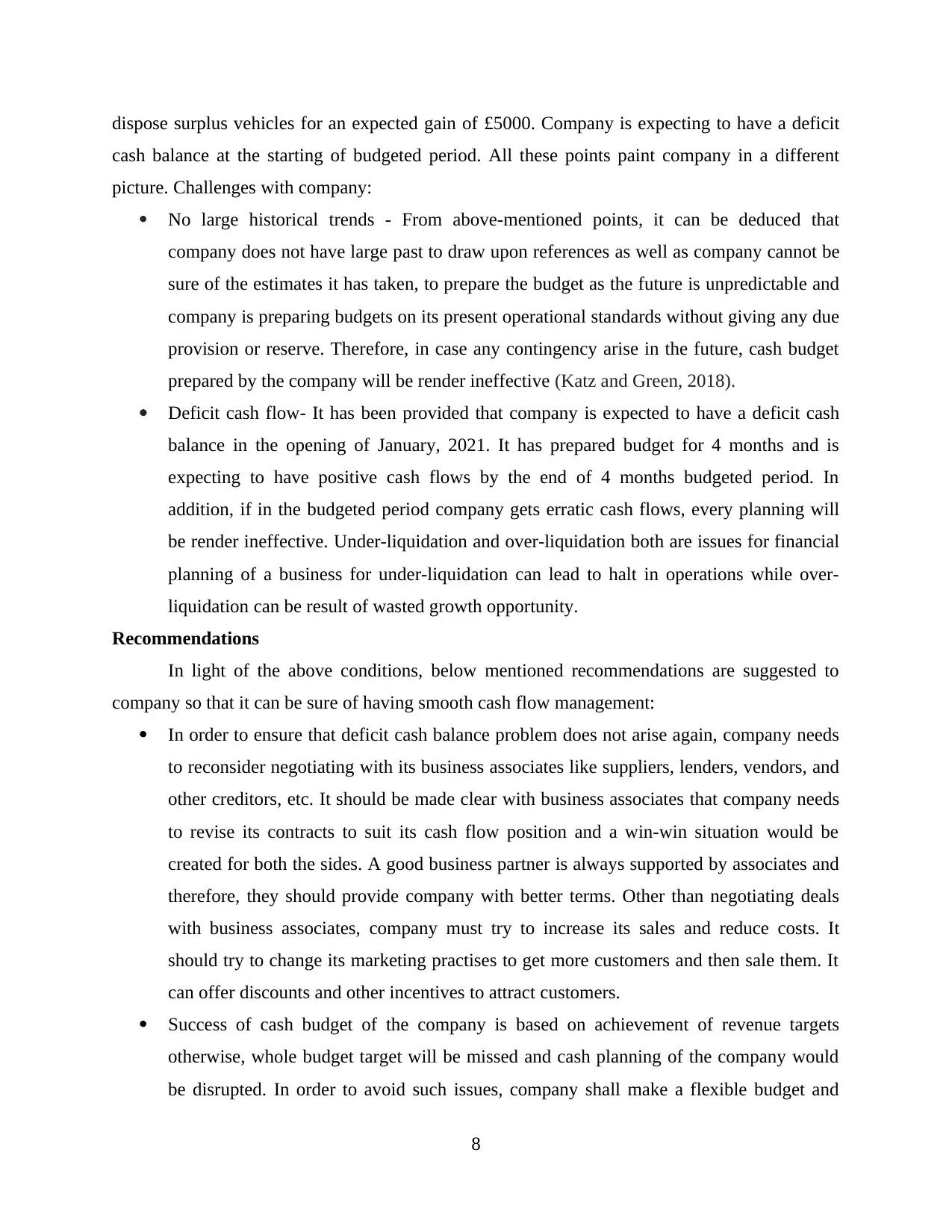
dispose surplus vehicles for an expected gain of £5000. Company is expecting to have a deficit
cash balance at the starting of budgeted period. All these points paint company in a different
picture. Challenges with company:
No large historical trends - From above-mentioned points, it can be deduced that
company does not have large past to draw upon references as well as company cannot be
sure of the estimates it has taken, to prepare the budget as the future is unpredictable and
company is preparing budgets on its present operational standards without giving any due
provision or reserve. Therefore, in case any contingency arise in the future, cash budget
prepared by the company will be render ineffective (Katz and Green, 2018).
Deficit cash flow- It has been provided that company is expected to have a deficit cash
balance in the opening of January, 2021. It has prepared budget for 4 months and is
expecting to have positive cash flows by the end of 4 months budgeted period. In
addition, if in the budgeted period company gets erratic cash flows, every planning will
be render ineffective. Under-liquidation and over-liquidation both are issues for financial
planning of a business for under-liquidation can lead to halt in operations while over-
liquidation can be result of wasted growth opportunity.
Recommendations
In light of the above conditions, below mentioned recommendations are suggested to
company so that it can be sure of having smooth cash flow management:
In order to ensure that deficit cash balance problem does not arise again, company needs
to reconsider negotiating with its business associates like suppliers, lenders, vendors, and
other creditors, etc. It should be made clear with business associates that company needs
to revise its contracts to suit its cash flow position and a win-win situation would be
created for both the sides. A good business partner is always supported by associates and
therefore, they should provide company with better terms. Other than negotiating deals
with business associates, company must try to increase its sales and reduce costs. It
should try to change its marketing practises to get more customers and then sale them. It
can offer discounts and other incentives to attract customers.
Success of cash budget of the company is based on achievement of revenue targets
otherwise, whole budget target will be missed and cash planning of the company would
be disrupted. In order to avoid such issues, company shall make a flexible budget and
8
cash balance at the starting of budgeted period. All these points paint company in a different
picture. Challenges with company:
No large historical trends - From above-mentioned points, it can be deduced that
company does not have large past to draw upon references as well as company cannot be
sure of the estimates it has taken, to prepare the budget as the future is unpredictable and
company is preparing budgets on its present operational standards without giving any due
provision or reserve. Therefore, in case any contingency arise in the future, cash budget
prepared by the company will be render ineffective (Katz and Green, 2018).
Deficit cash flow- It has been provided that company is expected to have a deficit cash
balance in the opening of January, 2021. It has prepared budget for 4 months and is
expecting to have positive cash flows by the end of 4 months budgeted period. In
addition, if in the budgeted period company gets erratic cash flows, every planning will
be render ineffective. Under-liquidation and over-liquidation both are issues for financial
planning of a business for under-liquidation can lead to halt in operations while over-
liquidation can be result of wasted growth opportunity.
Recommendations
In light of the above conditions, below mentioned recommendations are suggested to
company so that it can be sure of having smooth cash flow management:
In order to ensure that deficit cash balance problem does not arise again, company needs
to reconsider negotiating with its business associates like suppliers, lenders, vendors, and
other creditors, etc. It should be made clear with business associates that company needs
to revise its contracts to suit its cash flow position and a win-win situation would be
created for both the sides. A good business partner is always supported by associates and
therefore, they should provide company with better terms. Other than negotiating deals
with business associates, company must try to increase its sales and reduce costs. It
should try to change its marketing practises to get more customers and then sale them. It
can offer discounts and other incentives to attract customers.
Success of cash budget of the company is based on achievement of revenue targets
otherwise, whole budget target will be missed and cash planning of the company would
be disrupted. In order to avoid such issues, company shall make a flexible budget and
8
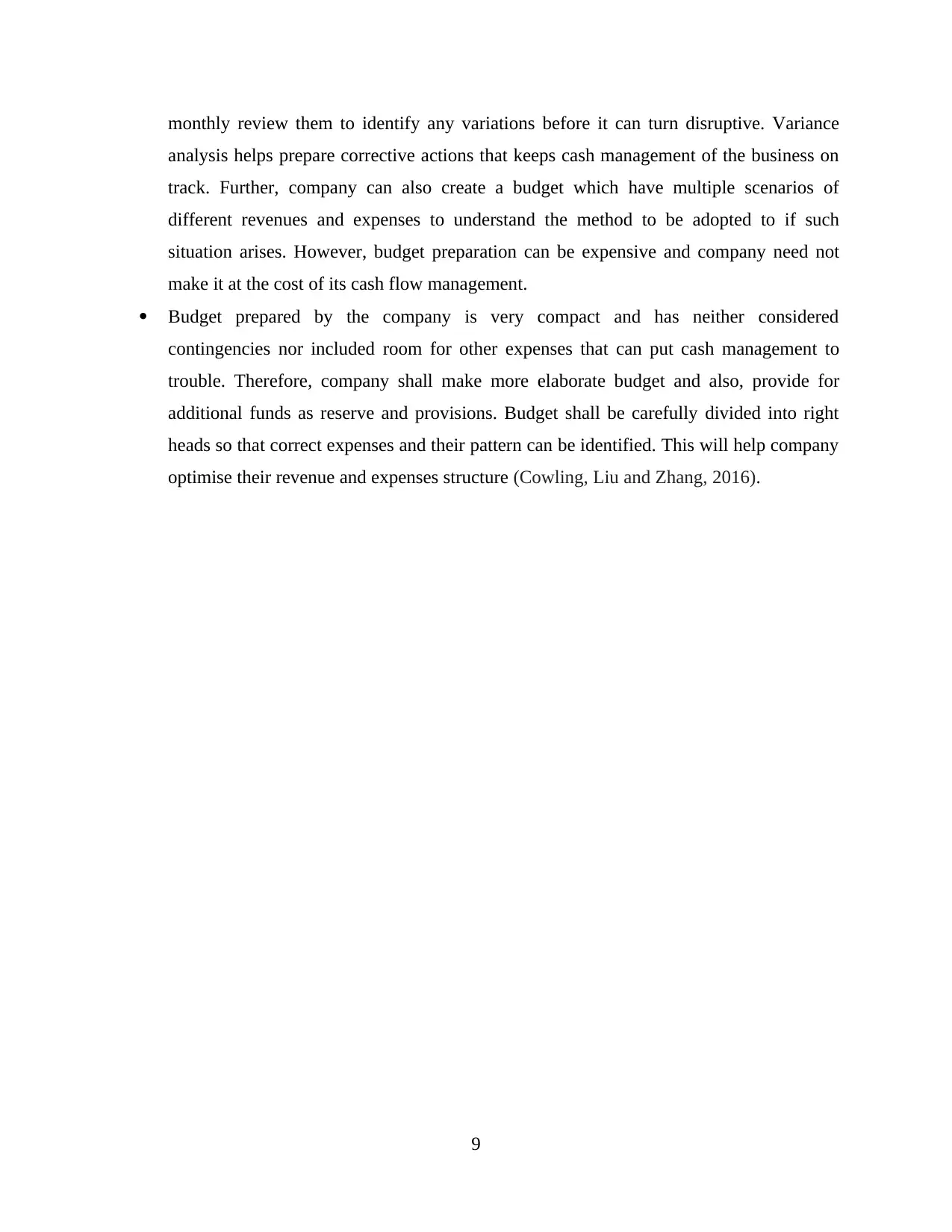
monthly review them to identify any variations before it can turn disruptive. Variance
analysis helps prepare corrective actions that keeps cash management of the business on
track. Further, company can also create a budget which have multiple scenarios of
different revenues and expenses to understand the method to be adopted to if such
situation arises. However, budget preparation can be expensive and company need not
make it at the cost of its cash flow management.
Budget prepared by the company is very compact and has neither considered
contingencies nor included room for other expenses that can put cash management to
trouble. Therefore, company shall make more elaborate budget and also, provide for
additional funds as reserve and provisions. Budget shall be carefully divided into right
heads so that correct expenses and their pattern can be identified. This will help company
optimise their revenue and expenses structure (Cowling, Liu and Zhang, 2016).
9
analysis helps prepare corrective actions that keeps cash management of the business on
track. Further, company can also create a budget which have multiple scenarios of
different revenues and expenses to understand the method to be adopted to if such
situation arises. However, budget preparation can be expensive and company need not
make it at the cost of its cash flow management.
Budget prepared by the company is very compact and has neither considered
contingencies nor included room for other expenses that can put cash management to
trouble. Therefore, company shall make more elaborate budget and also, provide for
additional funds as reserve and provisions. Budget shall be carefully divided into right
heads so that correct expenses and their pattern can be identified. This will help company
optimise their revenue and expenses structure (Cowling, Liu and Zhang, 2016).
9
⊘ This is a preview!⊘
Do you want full access?
Subscribe today to unlock all pages.

Trusted by 1+ million students worldwide
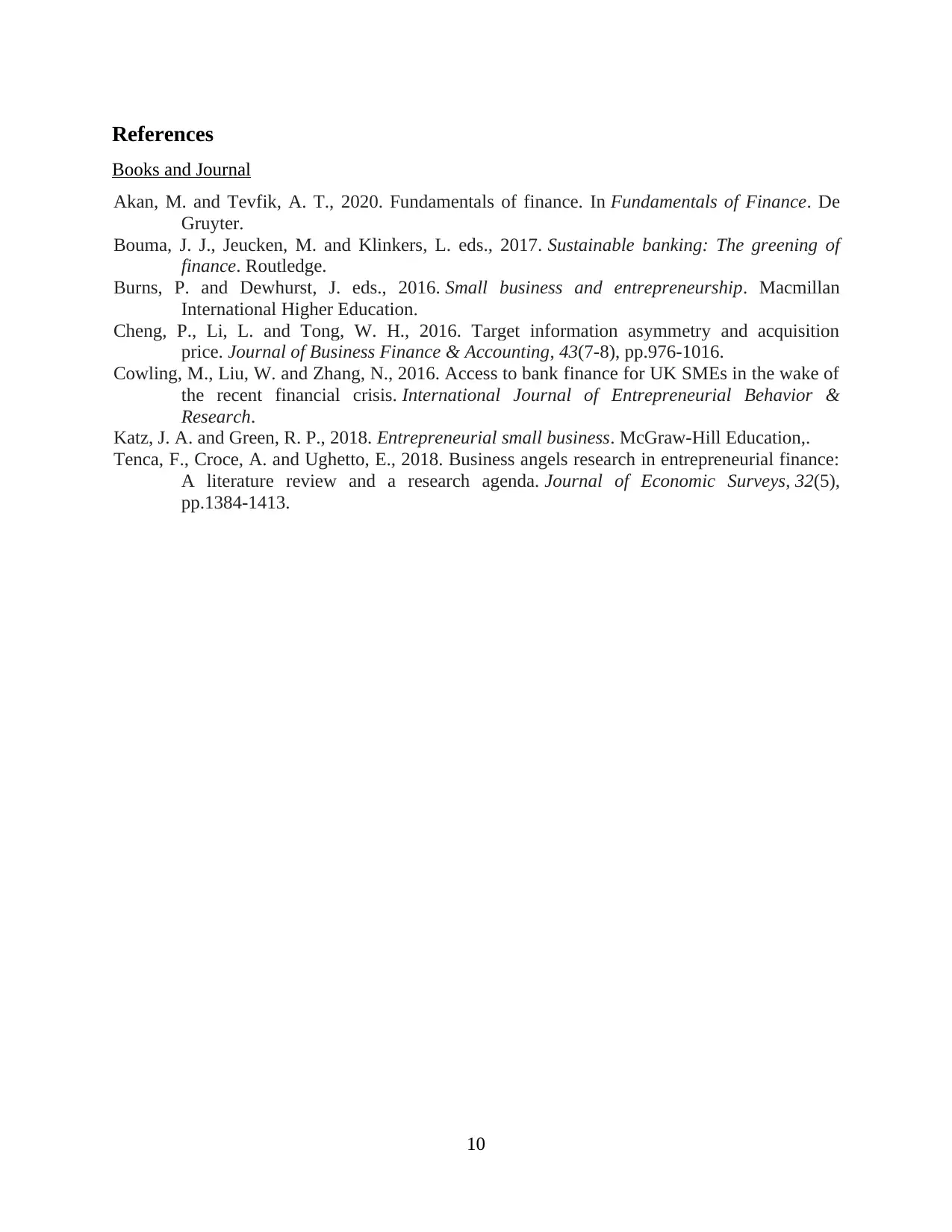
References
Books and Journal
Akan, M. and Tevfik, A. T., 2020. Fundamentals of finance. In Fundamentals of Finance. De
Gruyter.
Bouma, J. J., Jeucken, M. and Klinkers, L. eds., 2017. Sustainable banking: The greening of
finance. Routledge.
Burns, P. and Dewhurst, J. eds., 2016. Small business and entrepreneurship. Macmillan
International Higher Education.
Cheng, P., Li, L. and Tong, W. H., 2016. Target information asymmetry and acquisition
price. Journal of Business Finance & Accounting, 43(7-8), pp.976-1016.
Cowling, M., Liu, W. and Zhang, N., 2016. Access to bank finance for UK SMEs in the wake of
the recent financial crisis. International Journal of Entrepreneurial Behavior &
Research.
Katz, J. A. and Green, R. P., 2018. Entrepreneurial small business. McGraw-Hill Education,.
Tenca, F., Croce, A. and Ughetto, E., 2018. Business angels research in entrepreneurial finance:
A literature review and a research agenda. Journal of Economic Surveys, 32(5),
pp.1384-1413.
10
Books and Journal
Akan, M. and Tevfik, A. T., 2020. Fundamentals of finance. In Fundamentals of Finance. De
Gruyter.
Bouma, J. J., Jeucken, M. and Klinkers, L. eds., 2017. Sustainable banking: The greening of
finance. Routledge.
Burns, P. and Dewhurst, J. eds., 2016. Small business and entrepreneurship. Macmillan
International Higher Education.
Cheng, P., Li, L. and Tong, W. H., 2016. Target information asymmetry and acquisition
price. Journal of Business Finance & Accounting, 43(7-8), pp.976-1016.
Cowling, M., Liu, W. and Zhang, N., 2016. Access to bank finance for UK SMEs in the wake of
the recent financial crisis. International Journal of Entrepreneurial Behavior &
Research.
Katz, J. A. and Green, R. P., 2018. Entrepreneurial small business. McGraw-Hill Education,.
Tenca, F., Croce, A. and Ughetto, E., 2018. Business angels research in entrepreneurial finance:
A literature review and a research agenda. Journal of Economic Surveys, 32(5),
pp.1384-1413.
10
Paraphrase This Document
Need a fresh take? Get an instant paraphrase of this document with our AI Paraphraser
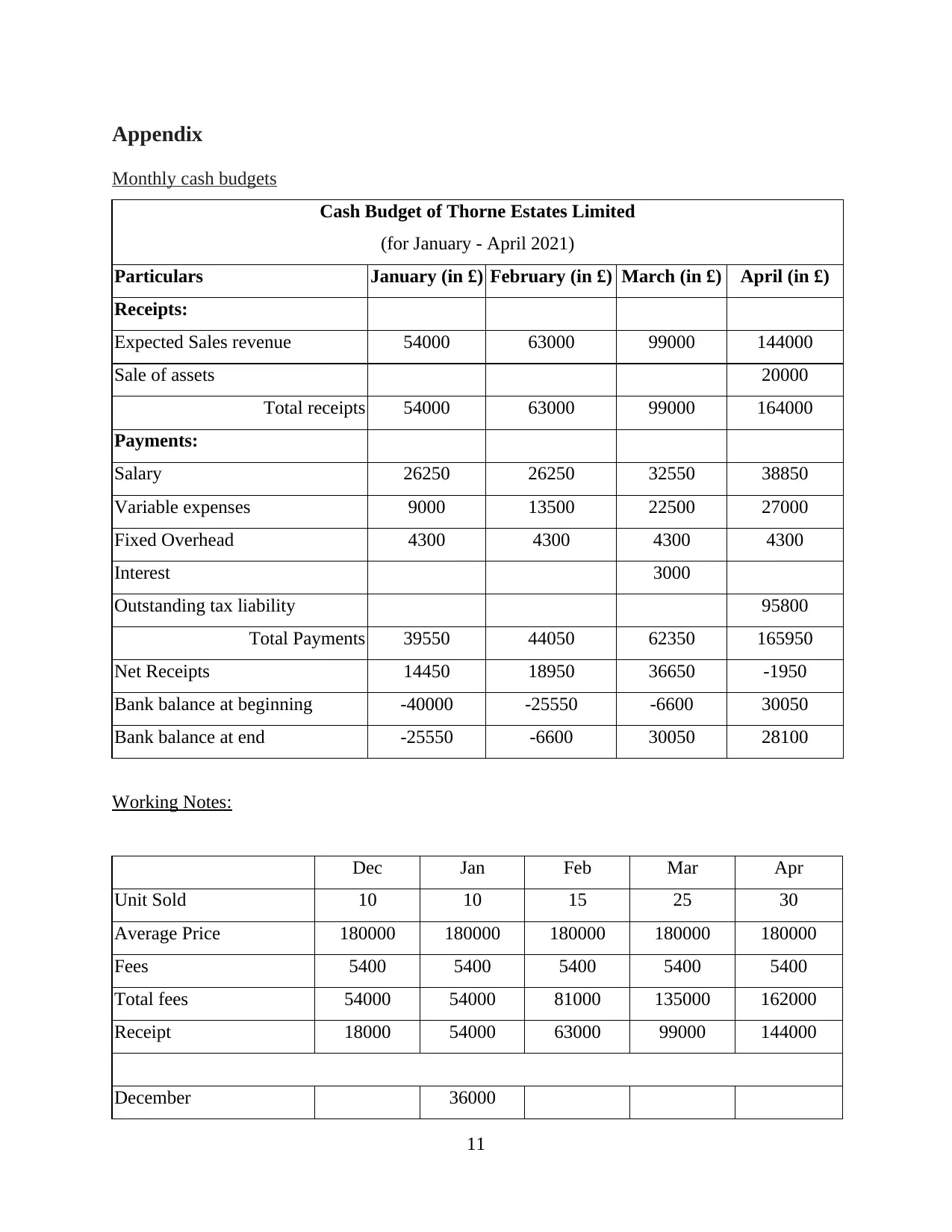
Appendix
Monthly cash budgets
Cash Budget of Thorne Estates Limited
(for January - April 2021)
Particulars January (in £) February (in £) March (in £) April (in £)
Receipts:
Expected Sales revenue 54000 63000 99000 144000
Sale of assets 20000
Total receipts 54000 63000 99000 164000
Payments:
Salary 26250 26250 32550 38850
Variable expenses 9000 13500 22500 27000
Fixed Overhead 4300 4300 4300 4300
Interest 3000
Outstanding tax liability 95800
Total Payments 39550 44050 62350 165950
Net Receipts 14450 18950 36650 -1950
Bank balance at beginning -40000 -25550 -6600 30050
Bank balance at end -25550 -6600 30050 28100
Working Notes:
Dec Jan Feb Mar Apr
Unit Sold 10 10 15 25 30
Average Price 180000 180000 180000 180000 180000
Fees 5400 5400 5400 5400 5400
Total fees 54000 54000 81000 135000 162000
Receipt 18000 54000 63000 99000 144000
December 36000
11
Monthly cash budgets
Cash Budget of Thorne Estates Limited
(for January - April 2021)
Particulars January (in £) February (in £) March (in £) April (in £)
Receipts:
Expected Sales revenue 54000 63000 99000 144000
Sale of assets 20000
Total receipts 54000 63000 99000 164000
Payments:
Salary 26250 26250 32550 38850
Variable expenses 9000 13500 22500 27000
Fixed Overhead 4300 4300 4300 4300
Interest 3000
Outstanding tax liability 95800
Total Payments 39550 44050 62350 165950
Net Receipts 14450 18950 36650 -1950
Bank balance at beginning -40000 -25550 -6600 30050
Bank balance at end -25550 -6600 30050 28100
Working Notes:
Dec Jan Feb Mar Apr
Unit Sold 10 10 15 25 30
Average Price 180000 180000 180000 180000 180000
Fees 5400 5400 5400 5400 5400
Total fees 54000 54000 81000 135000 162000
Receipt 18000 54000 63000 99000 144000
December 36000
11
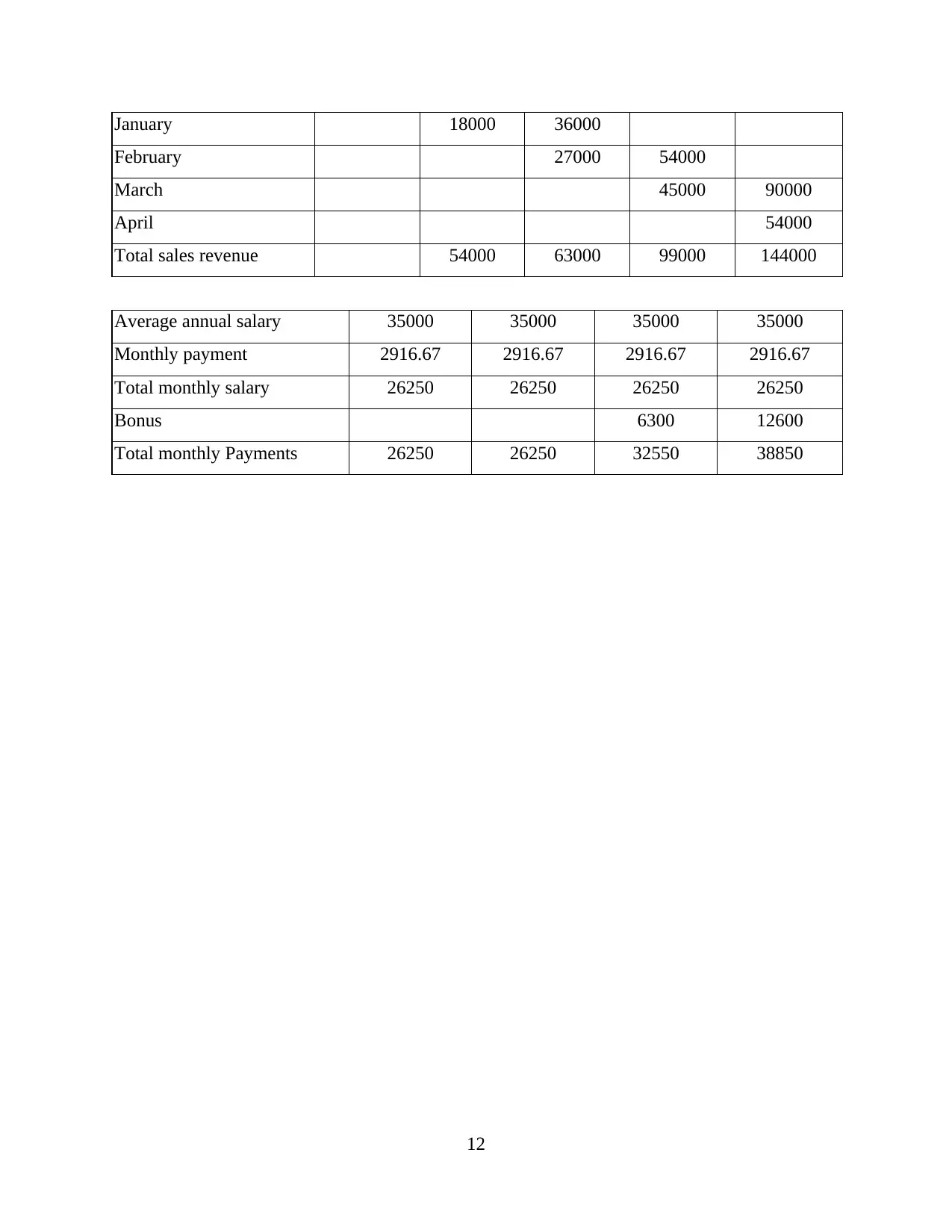
January 18000 36000
February 27000 54000
March 45000 90000
April 54000
Total sales revenue 54000 63000 99000 144000
Average annual salary 35000 35000 35000 35000
Monthly payment 2916.67 2916.67 2916.67 2916.67
Total monthly salary 26250 26250 26250 26250
Bonus 6300 12600
Total monthly Payments 26250 26250 32550 38850
12
February 27000 54000
March 45000 90000
April 54000
Total sales revenue 54000 63000 99000 144000
Average annual salary 35000 35000 35000 35000
Monthly payment 2916.67 2916.67 2916.67 2916.67
Total monthly salary 26250 26250 26250 26250
Bonus 6300 12600
Total monthly Payments 26250 26250 32550 38850
12
⊘ This is a preview!⊘
Do you want full access?
Subscribe today to unlock all pages.

Trusted by 1+ million students worldwide
1 out of 12
Related Documents
Your All-in-One AI-Powered Toolkit for Academic Success.
+13062052269
info@desklib.com
Available 24*7 on WhatsApp / Email
![[object Object]](/_next/static/media/star-bottom.7253800d.svg)
Unlock your academic potential
Copyright © 2020–2025 A2Z Services. All Rights Reserved. Developed and managed by ZUCOL.





